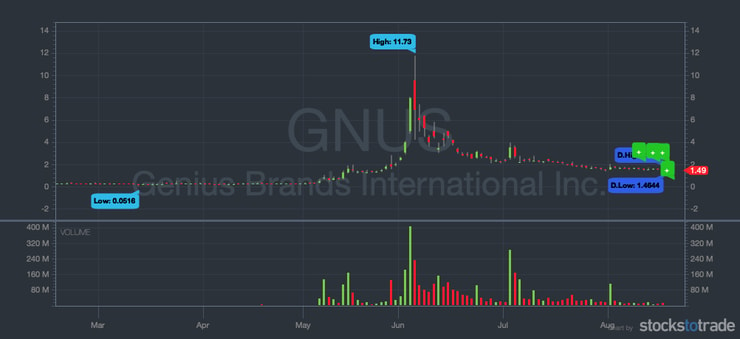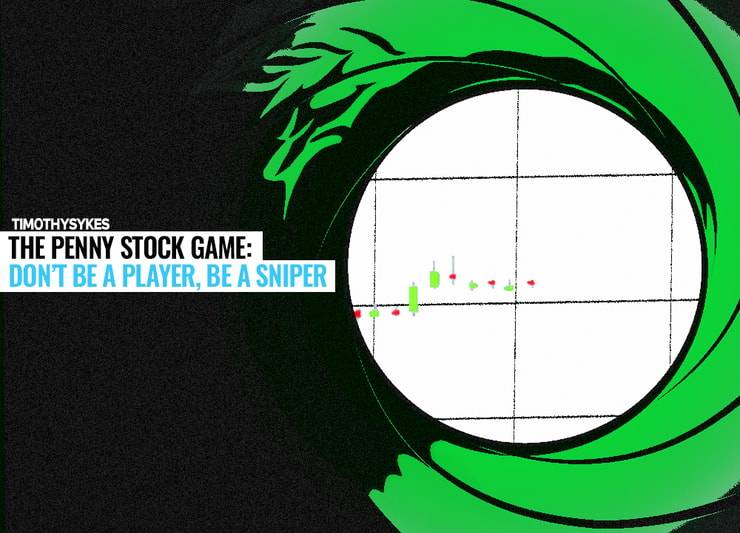Wanna be a stock market winner? You’ve gotta learn the rules of the penny stock game.
Plenty of people will tell you to stay away from penny stocks. The media loves to blast them.
Haters say that penny stocks are volatile and risky, and there’s little prospect of long-term growth.
Actually, I mostly agree. Penny stocks are usually junk. That’s why I don’t invest in penny stocks — I trade them.
I don’t hate penny stocks. Where others see danger, I see opportunity. I’ve made millions trading penny stocks.*
That’s because I have a different mindset and approach. My students do too, and they’ve been killing it with record profits in recent months.*
I’ve learned how the niche works. For me, these tickers are just pawns in the penny stock game.
If you want to take advantage of the opportunities that pumped-up penny stocks provide, you’ve gotta understand the players and how the game works. Read on to learn how to play…
(*Please note: My trading results, along with the results of my top students are far from typical. Individual results will vary. Most traders lose money. My top students and I have the benefit of many years of hard work and dedication. Trading is inherently risky. Do your due diligence and never risk more than you can afford to lose.)
Table of Contents
Pump It Up
It’s confusing, right? Why would I trade stocks that I know will probably fail?
Because I know that even though these penny stocks will probably fail in the long run, there’s still potential for short-term gains.
A penny stock could experience a massive explosion before it fails. That’s a pattern I call the supernova.
My role in the penny stock game is to take advantage of these spikes, capturing the meat of the move and moving on before it fizzles out.
How do I know what’s gonna happen? Well, it’s not rocket science…
Know The Players
Before you can understand the predictability of the penny stock game, get to know the players.
We’ve got the companies, the promoters, and the newbies.
The companies. That’s self-explanatory.
The promoters. They’re the ones hyping up the stock. They might be connected to the companies, or they might not be.
The newbies. These are uneducated traders who believe the hype, fall in love with the companies, and load up on shares. What they don’t know can — and usually does — hurt them.
And then you have a different group of people…
The traders like my students and me who understand it’s all a charade. We swoop in to potentially profit from the painfully predictable patterns that play out as a result of these ridiculous promoters.
A Predictable Plot Line
Think about a typical action movie. There’s a hero, there’s a conflict. They beat up a bunch of people and save the day. Happily ever after, roll credits. If you’ve seen one, you’ve seen ‘em all.
The penny stock plotline is a little different. But it’s usually just as formulaic and predictable. It goes like this:
- It all starts with a penny stock.
- The stock gets pumped up, either via promoters, the company, or trading chat rooms.
- Newbies believe the hype and buy. As more people buy, more people get FOMO and jump in.
- The price keeps going up.
- The people who engineered the inflated price get out while the getting’s good, leaving the newbies holding the bag.
- The newbies who lost money start crying about how penny stocks are the devil.
No, not every single stock will follow this trajectory.
Some never spike. Some spike over and over. A rare few will actually become ‘real’ companies.
But the cycle I just listed happens often enough. I’ve seen it countless times over the years.
I don’t want to analyze a company’s long-term prospects. The hows and whys behind this phenomenon don’t interest me.
It’s not my job to figure out why people do what they do. It’s my job to recognize these patterns and help you recognize them too.
I want to help you get smart about figuring out where you can benefit from this game without being left holding the bag. In short, I want to teach you to play the penny stock game.
Penny Stock Promotion: The Basics
Read this carefully, because this happens again and again. And again.
When it comes to pumping up a penny stock’s price, you’ve got two opposing forces: people who stand to benefit from the pumped-up price, and people who will become victims of it.
Or if you prefer, the people who pretend to be dumb, and the people who are actually dumb … and innocent.
Trust me, you don’t want to be part of either group.
You don’t want to profit because you’re purposefully taking advantage of people. But you also don’t want to be a sucker.
So I propose that you join a different faction: the group of smart traders like my students and me who trade like snipers.
Prop It, Then Drop It
Let’s talk about XpresSpa Group Inc. (NASDAQ: XSPA.) This is an airport massage spa company. It decided to diversify in the face of the COVID-19 pandemic by offering virus testing.
Not a terrible idea, right? It had a huge run-up, but it’s come down.

But recently, some shady things happened.
First, the company started getting some good attention. For instance, the CEO was featured on Fox Business talking about how great the company was…
Then, quietly, after hours on a Friday, the company announced an S-3 filing … for an offering of $200 million worth of stock.
Riddle me this: why would announce this on Friday after hours? Because they didn’t want people to see it.
Props to $XSPA for being typically shady, $200 million S-3 filing on a Friday after-hours, hoping most people don't see it…right after very positive interviews yesterday, very similar to the $GNUS dilutive machine and they have the same promoters too, what a coincidence, right?
— Timothy Sykes (@timothysykes) July 24, 2020
They wanted people to focus on the positive news and get sucked into buying without realizing that it’s a dilution dump.
Did I know for sure that the price would go up then fall?
No, I didn’t know for sure.
But XSPA had run in the past, and it didn’t keep going up. Why should it be different this time?
Good news, hype, and secretive action behind the scenes. First, they prop it … then they drop it.
It’s Happened Before
Newbies might see a company like this on the news and think it’s gonna change the world. They see it talked up in chat rooms and load up on shares.
Sure, a company like XSPA could change the world. But probably not.
Let’s get some perspective with another ticker: Genius Brands International Inc. (NASDAQ: GNUS.)
This stock had a real catalyst — a shareholder letter. I learned it from the Breaking News tool on StocksToTrade — one of my favorite new tools. It’s the best way to filter stock news right now.
The stock looked good. It had news. The CEO was talking up the company. New products, new partnerships — new and amazing everything!
It was one of the most actively traded stocks on Robinhood.
Newbies thought they’d struck gold. But behind all the news and excitement…
The company quietly doubled its number of shares outstanding, effectively diluting the stock. Easy to miss if you didn’t do your research, even though I warned about it…
LOL you gotta love $GNUS pumpers on $TWTR meanwhile the company is selling shares for 35 cents/share to raise $2.8 million, I wonder if those pumping on $TWTR are getting paid and how much….hmmmmmmmm #sketchy
— Timothy Sykes (@timothysykes) May 7, 2020
Read all about it in this post. It was all a joke. Now GNUS is back to the $1s.

It was a dilutive machine, and guess what? It had some of the same people promoting it as XSPA. What a coincidence!
This is why I teach. So that people can understand the pattern.
What I Really Want…
Some people say that I want these stocks to fail and that’s why I’m a naysayer.
I don’t want them to fail. I actually want them to go as high as they can.
Remember, I trade these stocks! I bought XSPA. I bought GNUS. If they spike, I can potentially benefit. So can my students.
I’ve also bought others following a similar pattern — like UAVS and MARK.
But I know that, eventually, what goes up will come down.
Please understand this. I have no way of knowing if these companies will succeed in the long term.
Experience has taught me how the patterns play out. I’ve seen it too many times. It happened all the time with pot stocks a few years ago. I was even featured in a Men’s Journal article about it.
I can’t ignore history.
I don’t always know how these pumped stocks will play out. Sometimes I’m right and sometimes I’m wrong. I post every trade publicly, so it’s not hard to see that I’m wrong about 25% of the time.
It’s just how the penny stock game works.
Playing the Penny Stock Game
You’ve heard ‘don’t hate the player, hate the game,’ right?
With penny stocks, it’s the opposite. Hate the players and love the game … and beat the players at their own game.
That’s my approach.
People will say I’m fear-mongering. That I’ll end up embarrassed when these stocks go “to the moon.”My response? Let this be the little penny stock that does big things. I might even trade it as it goes up.
But I’m not gonna hold forever or be a bagholder. I know how the story goes.
History matters. And it repeats a lot. That’s why I always have a plan and know to cut losses quickly.
Really, what I’m doing with this game is playing historical trivia. By highlighting historical stats, you start to see the same patterns over and over.
That’s how I know that even if there’s sketchy behavior, you can still ride the momentum and potentially profit.
Trading isn’t about caring about the companies. It’s about knowing the formula.
The Right Mindset for the Penny Stock Game

My top student Roland Wolf was once a pro soccer player. Then an ankle injury abruptly put a cap on his career. But the skills Roland learned playing sports at a professional level actually helped him in the penny stock game.
He didn’t get it right away … Roland admits he tried to follow me into some trades in his early days. But he quickly learned that wasn’t going to work. In this game, you have to learn to think for yourself and become self-sufficient.
So Roland applied his athlete mindset to learning to trade penny stocks. He’s now up to $1 million in trading profits in four years of trading. He started with just $4K.*
And no, you don’t need to be an athlete — or a nerd — to get this. You need discipline to learn how it works and you need to open your eyes to how this niche really works.
That brings me to my gratitude for promoters…
Open Letter to Penny Stock Promoters
Dear Penny Stock Promoters,
I know you hate me. But if you’re writing a press release, hyping a stock on social media, or trying to take advantage of uneducated newbies…
You’re actually creating opportunities for me. You’re creating opportunities for my students.
We’ve studied, and we understand the past.
I want to thank you for what you do.
Thanks to you, I’m trading successfully. I’m able to give back and make charitable donations with my trading profits.*
Stocks just had their best 100 days EVER so I’ve made $506k in trading profits, ALL donated to charity! While my charity @karmagawa announced a $1 million donation to Yemen, there‘s new crises in Lebanon, Mauritius & Bali so can you guess how much more $ we’re donating tomorrow? pic.twitter.com/AEd7VcshbS
— Timothy Sykes (@timothysykes) August 18, 2020
I know you’re probably crashing in your mom’s basement and living off of energy drinks. You probably don’t get much sun or nutrition.
That’s why, to thank you for the opportunities you’ve created, I’d like to send you a fresh-fruit gift basket. I really think the vitamins and minerals will do you good. And really, after what you’ve given me and my students, it’s the least I can do.
Love,
Tim
Don’t Get Played in the Penny Stock Game
I’ve figured out how to play the penny stock game. Do you wanna learn, too?
Start by learning the rules and building your knowledge account.
Look at patterns and stock dilution. This stuff happens again and again. The more you see it, the more you start to realize that it can be predictable.
Don’t get excited by these companies or buy into the hype. Know what’s going on behind the scenes. The people who run these companies are the architects of these spikes.
Trading Challenge
It’s my job to keep you from falling prey to the antics of promoters.
I can’t save everyone. Too many newbies just want hot stock picks. Those are the types of idiots who usually fall for blatant pumps.
For the students willing to take the time to really understand these patterns … consider applying for my Trading Challenge.
The Trading Challenge is based on my 20+ years of trading experience. If you want to start to understand these patterns fast, this is the most effective way to get smart. You’ll have a ton of resources at your fingertips — a huge video library, webinars, a great chat room community, and more.
Other great places to start? Here are a few great resources:
- NO-COST: “An American Hedge Fund: How I Made $2 Million as a Stock Operator & Created a Hedge Fund”
- FREE: My penny stock guide. A great starting point for new traders.
- LOW-COST: “The Complete Penny Stock Course.” My student Jamil wrote this … It’s a comprehensive review of my entire strategy. Don’t miss this book.
- LOW-COST: 30-Day Bootcamp. My $250K+ profit* student Matthew Monaco and I created this 30-day trading course. Traders of all levels can learn something. Plus, you get a copy of the “The Complete Penny Stock Course” as a bonus.
Are You Ready to Play?
What kind of player do you want to be in the penny stock game?
A promoter? Someone who falls for the hype?
Or would you rather be a part of the minority group of traders who trade like snipers?
I’ve made a career out of taking advantage of patterns that play out over and over in the stock market. Ready to join me?
Consider applying for my Trading Challenge … The world needs more smart traders!
Can you see the predictability of the penny stock game? Leave a comment and let me know if you understand!








Leave a reply